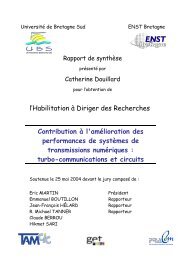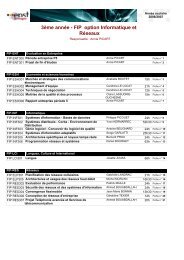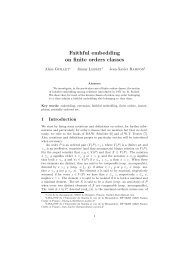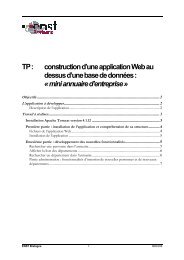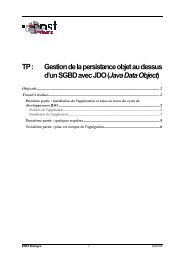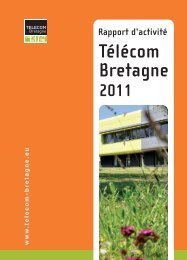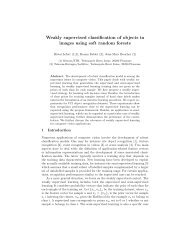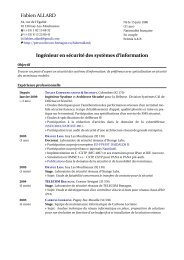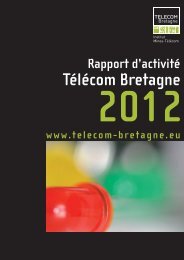researResearch - Télécom Bretagne
researResearch - Télécom Bretagne
researResearch - Télécom Bretagne
Create successful ePaper yourself
Turn your PDF publications into a flip-book with our unique Google optimized e-Paper software.
h Research<br />
9<br />
RESEARCH<br />
Main achievements of the project<br />
I - HSUPA 4 System :<br />
• Implementation of the transmission channel<br />
of the HSUPA system, in conformity with the<br />
3GPP norm.<br />
• Performance evaluation for the HSUPA<br />
system on the Gaussian channel, then on a<br />
multipath channel. Several configurations<br />
were studied, with the goal of meeting the<br />
needs of the operator, Orange. Rake and<br />
LMMSE receivers were used according to<br />
the system configuration.<br />
• Implementation of a rapid simulation<br />
methodology for HSUPA with power control,<br />
as well as HARQ retransmission techniques.<br />
• Integration of the 16-QAM modulation for<br />
HSUPA.<br />
II - Turbo Equalization :<br />
The Turbo equalization part deals essentially with<br />
the writing of articles (IEEE Com. Letters and<br />
IEEE Symposium on Turbo Codes) on the following<br />
two points:<br />
• Comparison of the performance on MIMO<br />
channels between single-carrier and multicarrier<br />
transmissions using an MMSE turbo<br />
equalizer as a receiver in the frequency<br />
domain.<br />
• Complexity reduction of MMSE equalizers by<br />
replacing a matrix inversion by its<br />
development in truncated series. Illustration<br />
of the contribution of this technique in turbo<br />
equalization.<br />
III- Studies of joint error-correcting<br />
coding and modulation techniques for<br />
PLC communication systems<br />
• Validation by simulation of Turbo-decoding<br />
adapted to Bernoulli-Gaussian type<br />
impulsive noise (modification of the Log-<br />
Likelihood Ratio (LLR)) channel information<br />
in BPSK 7 constellation. This method was<br />
proposed by Umehara for a class A<br />
Middleton-type impulsive noise.<br />
• Extension of the preceding method to multicarrier<br />
situations, with OFDM in particular.<br />
• Determination of the LLR modification for a<br />
4) HSUPA : High Speed Uplink Packet Access<br />
5) 3GPP : 3rd Generation Partnership Project<br />
system implementing a receiver amplitude<br />
limiter to fight impulsive noise. A study in<br />
BPSK and multicarrier (OFDM) was carried<br />
out. Important gains can be made for OFDM,<br />
whereas the exact calculation of LLR without<br />
using a limiter is still the best solution.<br />
• Proposition for an optimisation of the<br />
threshold value based on the parameters of<br />
impulsive noise (BG). Method based on<br />
signal detection theory. This approach offers<br />
the advantage of being able to be<br />
automatized because it adapts to SNR and to<br />
the characteristics of BG. Validation of the<br />
approach by simulation, in BPSK alone and<br />
in OFDM, and on the HPAV chain for various<br />
BG scenarios.<br />
• Behavior study of OFDM/OQAM in the<br />
presence of impulsive noise. Analytical proof<br />
and proof by simulation, from the identical<br />
behavior of OFDM and OQAM with a<br />
rectangular prototype. We also<br />
demonstrated the dependence of<br />
performance on the prototype used for a<br />
small number of carriers, and the<br />
asymptotic convergence toward OFDM when<br />
the number of carriers is increased.<br />
IV - SPARSITY :<br />
The sparse representation of signals consists of<br />
the representation of a signal with a small<br />
number of significant coefficients. By definition, a<br />
signal is called sparse when most of these<br />
coefficients are (approximately) null. The sparse<br />
representation of signals has seen an important<br />
upshoot over the past ten years. This has made it<br />
possible to successfully attack a number of signal<br />
processing and image problems. In compression,<br />
for example, the media coding standard JPEG and<br />
its successor, JPEG-2000, became the obvious<br />
choices when it came to image compression<br />
techniques by default. These two norms are based<br />
on the principle of transformational coding.<br />
The data vector representing the pixel line is<br />
transformed in a domain where it is sparse<br />
(meaning that it is represented in a new<br />
coordinate system with a small number of<br />
significant coefficients), and the resulting<br />
coordinates are then processed in order to<br />
produce the encoded binary output. JPEG<br />
6) LMMSE : Linear Minimum Mean Squared Error<br />
7) BPSK : Binary phase-shift keying<br />
75



